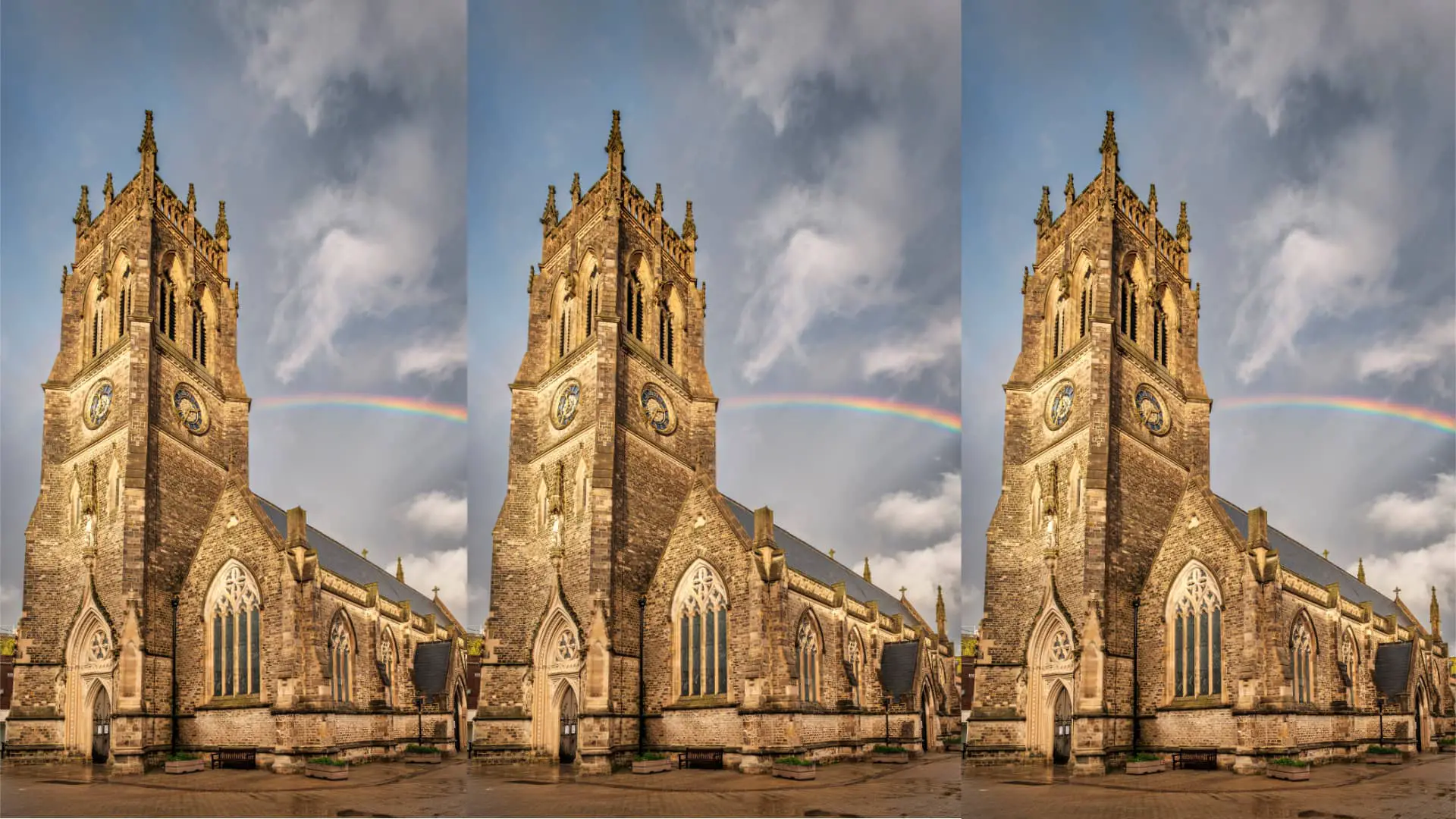Historic England has this week confirmed that no new sites on the Isle of Wight have been added to the Heritage at Risk Register in 2023.
However, the good news doesn’t end there because one Isle of Wight site, which was first listed in 1953, has now been saved as removed from the list.
If you’ve walked through St Thomas’s Square in recent years, you’ll have seen the important restoration work taking place to Newport Minister. Work has been possible on this Grade I listed building thanks to crucial support from The National Lottery Heritage Fund.
Newport Minster is the Isle of Wight’s main Anglican church, and now one of the significant sites saved and removed from the Heritage At Risk Register.
Jacqueline Gazzard, Chair of the Friends of Newport Minster, told News OnTheWight,
“Taking the Minster off the At Risk Register is another milestone and it is so exciting to see the building start to come to life again.
“Thanks to the team at the heart of this parish, as well as all the funders who have made this happen, we will have a wonderful church, as well as a building ready to work for our community for another one hundred and sixty years.”
What is the Heritage At Risk Register?
The Register gives an annual snapshot of the health of England’s valued historic buildings and places.
Historic buildings are added to the Register because they are at risk of neglect, decay or inappropriate development. In the past 15 years, 25 sites across the South East have been saved and their futures secured.
In England, there are 4,871 entries on the Heritage at Risk Register in 2023 – 48 fewer than in 2022. There are now 454 buildings and sites in the South East on the Heritage at Risk Register.
25th anniversary
This year marks the 25th anniversary of the publication of the first national Heritage at Risk Register (previously known as the Buildings at Risk Register).
Over the past 25 years, since it began in 1998, around 6,800 entries have been removed. This equates to around three-quarters of the entries that were on the original Register.
Many of the remaining entries from the 1998 Register have seen good progress despite often being the hardest cases to solve.
Isle of Wight listed items
For a list of Isle of Wight sites still on the list, see the table below
| Entry name | Summary |
|---|---|
| Church of St Paul's, Regent Street, Shanklin | Town centre church designed by CL Luck 1875-90, with west porch added 1911. Built of local Greensand stone with tiled roofs and slender tower with timber framed top storey and shingled roof. At risk due to timber decay to top of tower, decaying stonework, bulging window glazing, and slipped and missing shingles. Phase One repairs to the main roofs, rainwater goods and high level stonework were successfully completed in 2016 with the help of a grant from Historic England/National Lottery Heritage Fund. Further phases of repair are now required. |
| St Mary's Roman Catholic Church, High Street, Ryde | Town centre church on compact site designed by Joseph Hansom in the Gothic style. It was mainly built 1846-8 of rubble limestone with unusual angular pantile roofs. Listed Places of Worship Roof Repair Fund grant aided repairs to the roofs and Covid 19 Emergency Grant funded report on internal decorative scheme, but conservation work to this is required. |
| Holy Trinity Church, Trinity Road, Ventnor | Victorian church in the Early English style by the architect CE Giles. Nave, aisles and chancel with slender tower and spire at the south east corner. Built of soft local stone with concrete tiles on the roof. The main problem is the soft stone work which continues to decay. Some repairs have been carried out to the tower. |
| Church of St Mary, Church Road, Cowes | Large church adjacent to Northwood Park. The west tower was designed by John Nash in 1816 and the rest of the church was rebuilt in 1867. Built of stone with colour banded slate roof. Historic England/National Lottery Heritage Fund grant-aided repairs to tower and north roof slopes but further repairs needed including to the south nave and aisle roofs, rainwater disposal, and addressing structural movement to south west corner, which is currently being monitored. |
| Church of St James, East Cowes | A C19 church by local Isle of Wight architect T Hellyer. Constructed in Romanesque style of stone rubble with slated roof. Incorporates tower of earlier 1830s church by John Nash. Nash is buried in the church yard. Repairs, including to the rainwater goods and south transept rose window, have been completed but further works are required to address the structural problems to the north vestry. |
| Norris Castle, East Cowes | Norris is an exemplar marine villa with castellated model farm/walled garden from 1799 by James Wyatt for Lord Seymour as part of the early villa development on the Solent. A particularly fine and unusual example of its type the historical completeness of its key parkland features, parkland architecture and setting survives mostly intact. Benign neglect allowed the parkland features to survive relative to the Castle and farm that slowly declined due to lack of management. With major development proposals in 2022 a contextual report has been published to better understand the significance. |
| Remains of Old Quarr Abbey, Fishbourne Park Road, Binstead | Cistercian foundation of 1131. The upstanding remains are in an advanced state of decline due to longstanding lack of regular maintenance and vegetation growth. The National Lottery Heritage Fund grant aided repairs to the barn, some structures and walling as part of a wider project. Further repairs are necessary to remove the remains from the Heritage at Risk Register. Historic England grant-aided an update of the condition survey, hydrological survey and temporary propping of the leaning east precinct wall which was in danger of collapse. |
| Bouldnor Battery, Shalfleet | Battery built in 1938 situated on the west coast of the Isle of Wight to help protect the Solent. Buried components no longer accessible but survive. Mainly constructed from reinforced concrete which is now spalling and decaying due to corrosion of the internal reinforcement. Historic England has grant-aided temporary propping and waterproofing of the roofs. An Options Appraisal, also grant-aided by Historic England, was completed in early 2020 and options for the repair and possible re-use of the monument are being explored. |
| The Guildhall, High Street, Newport | Former Guildhall, now museum, in the centre of Newport. Designed by John Nash and constructed 1814-6, with clock tower added in 1887 for Queen Victoria's Golden Jubilee. Slate roofs, rendered walls and stone columns and dressings to tower. At risk due to deferred maintenance and defects to roofs, render, stonework and rainwater disposal. |
| Swainston, Calbourne | Mid-late C18 woodland garden, set in parkland, with intersecting avenues and water features incorporating earlier fishponds from a Bishopric manor, now a hotel. Remnant garden features lie in several ownerships and woodland compartments. Where parkland has been converted to arable land or and light industrial use loss of historic character and designed landscape intentions has occured.The southern portion of the estate, including a temple, is separated from the core by a road. A coordinated parkland/conservation management plan is recommended as part of any Countryside Stewardship process. |
| Yaverland Battery, Sandown | Royal Commission coastal battery completed in 1864 with later alterations. Mainly built of red brick with stone dressings. At risk due to vegetation growth and partial collapse of carnot wall. A plan for the long-term conservation of the monument needs to be developed with the owner. |
| Hammerhead Crane, Thetis Road, West Cowes | Giant cantilever crane, also called 'hammerhead' crane, built 1911. One of a handful of this type of crane now surviving in the world, and witness to a major local industry. Disused and surrounded by a potential development site. Historic England has been assisting the Local Authority with grant aid and technical advice. Essential holding repairs to the legs and upper structure have been undertaken under the auspices of an Urgent Works Notice. Historic England has grant-aided a feasibility study and will be working with all stakeholders on the site to secure the full repair of the crane. |
| Northwood House, Ward Avenue, Cowes | Large house, 1837, with spectacular interiors. The long-term future of this partly used building is unresolved and maintenance needs to be addressed in the short term. Some progress has been made and areas of the building have been brought back into use, but the comprehensive repair of the external envelope is still required. The Trustees of Northwood House have been urged to appoint a conservation architect, compile a full package of repairs and improvements and to engage with the National Lottery Heritage Fund. The cost of full repair is very high. |
| Medieval settlement 100m south east and 350m north east of East Ashey Manor Farm | |
| Church of St John, Carter Street, Sandown | A Victorian church in the Early English style; by the architect CL Luck. Walls of soft local stone, roof has concrete tiles. Nave and chancel, south aisle with south porch. Shingled spirelet. The main problem is the eroding stonework but also the roof over the clergy vestry leaks and there has been a partial collapse of the ceiling. A programme of repairs is required to address these issues. |
| Two bowl barrows 110m north-east of Heatherdown, Totland | Two bowl barrows grazed by cattle. The loss of rabbit proof fencing that previously protected the barrows has resulted in extensive deep rabbit burrowing and cattle scraping causing damage to both barrows. Scrub management also required. Management with NT and tenant needs to be confirmed. Management plan and repair strategy being discussed with owners and tenant |
| Norris Castle, Newbarn Road. East Cowes | Mock castle of 1799 by James Wyatt on a spectacular site overlooking the Solent. Constructed with galletted stone facings to the walls and slate roofs behind parapets. At risk due to backlog of maintenance, heritage crime and deterioration of significant historic fabric including to roofs, walls, windows and interiors. Historic England is working with representatives of the owners to address repairs in both the short and long term. |
| Church of All Saints, Church Hill, Godshill | Mainly dating from the C14 with an unusual plan of double nave and arcade continuous to chancel. Early C16 south transept with crucifixion wall painting of similar date. Historic England/National Lottery Heritage Fund grant-aided repairs to rainwater goods, drainage and south west corner, including west window to south nave, have been successfully completed. Further repairs required to the stonework. |
| Norris Castle Farm, the Bailiff's House, Two Cottages and Kitchen Garden Wall, Newbarn Road | Model Farm designed by James Wyatt around 1800. It includes farm buildings, Bailiff's house, cottages, walled garden and glass houses all contained within a rectangular plan surrounded by high castellated walls with corner towers. The walls are mainly built of rubble stonework with Welsh slate roofs to the buildings. At risk due to lack of long-term maintenance, leaking roofs and defective rainwater disposal. Proposals for repair and sustainable re-use are awaited from the owner. Some emergency repairs carried out. |
| Church of St John the Baptist, Drake Road, Newport. | Spacious Gothic style church to the south of Newport town centre. It was designed by R G Wetten and mainly constructed 1835-7 of rubblestone with ashlar buttresses and turrets and Roman cement window surrounds, mouldings and corbels. Slate roof behind tall parapets. At risk due to deterioration of the historic fabric including the stonework and window surrounds. |
| Church of St Saviour's on the Cliff, Queen's Road, Shanklin | Victorian church by Thomas Hellyer in the Early English style. Built of soft local limestone with tiled roof. The principal problem is the condition of the stonework which is badly spalled all over. The church is in a coastal location. The windows at the west end are very fragile and are protected with Perspex to prevent them from being blown out. Some repairs have been carried out, but more are required. In February 2021 the hall roof suffered storm damage. |
Article edit
6pm 10th Nov 2023 – Comment from JG added





